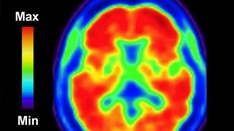A higher polygenic risk (PGR) score may predict late-onset Alzheimer's disease (LOAD), new research shows.
Investigators found a higher PGR was significantly linked to smaller hippocampal volume and poorer executive function in physically and cognitively healthy adults.

Rachana Tank
"Our study is a small, but hopefully robust, step forward," study investigator Rachana Tank, a PhD candidate and researcher, Institute of Health and Wellbeing, University of Glasgow, Glasgow, UK, told Medscape Medical News. "There is potential for PGR scores to supplement APOE in identifying onset of Alzheimer's."
The study was published online October 7 in Neuropsychopharmacology.
Improved Prediction?
PGR scoring is a way to estimate an individual's genetic risk of inheriting a trait or disease. There's evidence that using such scoring can improve prediction of AD.
However, previous studies examining LOAD-PGR generally had small sample sizes and didn't consistently control for potential confounding variables like smoking and socioeconomic deprivation.
The presence of the apolipoprotein e4 (APOE-ε4) allele is not necessary for LOAD to develop. Estimates of other genetic contributions to AD range from 50% to 79%.
The new analysis included 32,790 nondemented individuals with a mean age of 63 years from the UK Biobank.
Researchers conducted genotyping to arrive at a PGR score. To do this, they took summary data from a genome-wide association study (GWAS), an approach that identifies genetic variants associated with a particular disease.
In calculating weighted scores, researchers included 6.5 million single nucleotide polymorphisms (SNPs) or variants, associated with late onset AD (onset age >65 years).
The variants used to define APOE-ε4 status were not included in calculating PGR scores.
Key Brain Areas
The study's outcome measures included MRI volumes of key brain areas affected by AD, including total gray matter, white matter, white matter hyperintensity (WMH), whole brain, left hippocampus, right hippocampus, and segmented regions of each left and right hippocampus.
Cognitive measures included fluid intelligence, matrix completion, numerical memory, reaction time, total trail making (A + B) and symbol digit substitution.
In fully adjusted models, researchers controlled for age, sex, socioeconomic deprivation, smoking, body mass index (BMI), and APOE-ε4 genotype.
They also controlled for genotyping chip (two chips were used to measure variants for the UK Biobank participants), and eight genetic principal components (these provide information about population structure).
These variables were included "to avoid spurious association due to individuals sharing genetic ancestry or being genotyped on different chips," explained Tank.
Results showed LOAD-PGR was associated with left hippocampal volume in the fully adjusted model (β = −0.118, P = .002).
When examining hippocampal subdivisions, LOAD-PGR was associated with only left hippocampal body in the fully adjusted model (β = −0.069, P = .002).
LOAD-PGR scores were not associated with white matter hyperintensity, which on MRI are "the hallmark" of cerebrovascular impairments, have been associated with cognitive impairment, and may contribute to increased risk for dementia, said Tank.
Not Ready for Prime Time
One potential explanation for lack of evidence in this study is that white matter hyperintensity is linked to dementia through vascular risk factors and not directly. It also may have been too early in the lifetime for this type of brain measure to present, said Tank.
Two measures related to executive function were significantly associated with PGR in the fully adjusted model. These included fluid intelligence (β = −0.080, P = .002) and matrix completion (β = −0.102, P = .003).
The new findings suggest genetic risk variants for AD may pick up the earliest signs of pathology prior to cognitive problems, said Tank.
Although the findings are "statistically small in effect size" they "are in a relatively large sample size and adjusted for a number of potential confounders," said Tank.
Researchers analyzed interactions between APOE-ε4 genotype and LOAD-PGR score. As Tank explained, some research suggests genetic interactions between certain loci may be relevant in terms of effects on phenotype outcomes.
This study did not find that APOE was interacting with other genetic risk variants. "However, genetic interactions for complex traits are not well understood and there may have been potential methodological limitations as to why no interactions were found in this study," said Tank.
PGR scores may eventually be used in clinical practice as a tool to identify patients who may benefit from intervention treatments, said Tank.
However, further study is required, including investigations into whether PGR adds significant information compared with simple and inexpensive assessment of family history, she said.
"There are many obstacles that need to be understood and addressed before clinical implementation of PGR scores."
One study limitation is that the UK Biobank cohort individuals are relatively healthy, educated, and socioeconomically thriving. In addition, the analysis did not consider medications that may influence cognitive function such as benzodiazepines.
The authors note the study findings are not generalizeable to populations other than those with White European ancestry.
Potentially "Useful Tool"
Commenting on the findings for Medscape Medical News, Heather Snyder, PhD, Alzheimer's Association vice president of medical and scientific relations, said she welcomes studies that investigate genetic risks for AD.
"As we advance research into treatments and tools for early and accurate diagnosis for Alzheimer's, it's increasingly important to identify individuals that are at increased risk," she said.
This study, carried out in a large population, suggests that using a specific algorithm that combines brain imaging results and cognitive abilities with known risk genes for Alzheimer's may be a "useful tool to identify individuals with early Alzheimer's-related brain changes," she said.
However, more research is needed in larger, more diverse populations over a longer period of time to fully understand these links, Snyder added.
UK Biobank was established by the Wellcome Trust medical charity, Medical Research Council (MRC), Department of Health, Scottish Government, and the Northwest Regional Development Agency. It has also had funding from the Welsh Assembly Government and the British Heart Foundation. Tank, the study co-authors, and Snyder have disclosed no relevant financial relationships.
Neuropsychopharmacology. Published online October 7, 2021. Full text
For more Medscape Psychiatry news, join us on Twitter and Facebook
Credits:
Lead Image: iStock/Getty Images
Image 1: Neil Miller, University of Glasgow
Medscape Medical News © 2021
Send news tips to news@medscape.net.
Cite this: Polygenic Risk Score a New Tool for Predicting Late-Onset Alzheimer's? - Medscape - Oct 08, 2021.












Comments